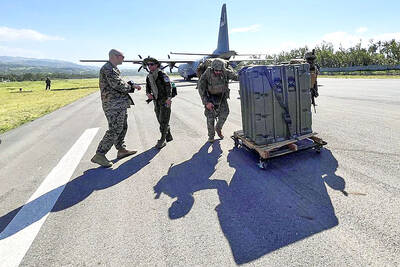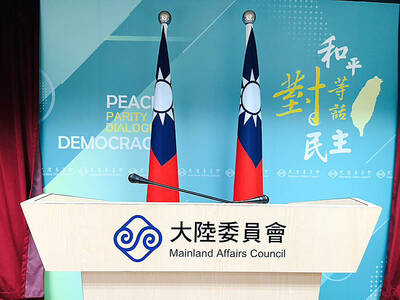The first Taiwan-US Science and Technology Cooperation Dialogue meeting was held in Taipei on Monday, part of a process the two nations hope will deepen bilateral scientific and technological collaboration.
The meeting was the first high-level strategic dialogue between the two sides since the signing of a Science and Technology Agreement in December 2020, the National Science and Technology Council (NSTC) said in a statement.
It focused on five topics: semiconductor research and applications, medical supply chain resilience, cancer research, environmental modeling and research, and research integrity in terms of diversity, equity, inclusion and accessibility, the NSTC said.
The US delegation was led by Acting Deputy Assistant Secretary of State of the Bureau of Oceans and International Environmental and Scientific Affairs Jason Donovan.
It included scientists and experts from the US’ National Science Foundation, National Institute of Standards and Technology, National Cancer Institute and National Oceanic and Atmospheric Administration.
NSTC Minister Wu Tsung-Tsong (吳政忠) and American Institute in Taiwan Acting Director Jeremy Cornforth gave introductory speeches at the opening of the meeting.
Representative to the US Hsiao Bi-khim (蕭美琴) and Jennifer R. Littlejohn, acting assistant secretary in the US Department of State’s Bureau of Oceans and International Environmental and Scientific Affairs delivered remarks virtually.
The US delegation was yesterday scheduled to visit the Industrial Technology Research Institute, the National Center for High-performance Computing, and the Hsinchu Biomedical Science Park (新竹生醫園區), the NSTC said.
In other news, the National Development Council on Monday approved a NT$43 billion (US$1.4 billion) plan to expand the Southern Taiwan Science Park (南部科學園區) to Kaohsiung’s Nanzih District (楠梓).
The Nanzih site would cover 175.3 hectares, including 29.83 hectares to be used for a new Taiwan Semiconductor Manufacturing Co (TSMC) wafer plant, the council said.
The site, which used to house a naphtha cracker owned by state-owned oil refiner CPC Corp, Taiwan, would become a science park to meet demand for advanced semiconductor manufacturing, Southern Taiwan Science Park director-general Su Chen-kang (蘇振綱) said.
The site for TSMC’s new wafer plant would be incorporated into the Southern Taiwan Science Park this year, while the remaining 145 hectares would become part of the park after a second environmental impact assessment is completed by 2025, Su said.
Other manufacturers would be able to move into the Nanzih area by then, he said.
The aim is to have the Nanzih section of the park accommodate software and hardware companies, Su said.
The Southern Taiwan Science Park currently consists of the Tainan Science Park (臺南科學園區) and the Kaohsiung Science Park (高雄科學園區).

Three batches of banana sauce imported from the Philippines were intercepted at the border after they were found to contain the banned industrial dye Orange G, the Food and Drug Administration (FDA) said yesterday. From today through Sept. 2 next year, all seasoning sauces from the Philippines are to be subject to the FDA’s strictest border inspection, meaning 100 percent testing for illegal dyes before entry is allowed, it said in a statement. Orange G is an industrial coloring agent that is not permitted for food use in Taiwan or internationally, said Cheng Wei-chih (鄭維智), head of the FDA’s Northern Center for

LOOKING NORTH: The base would enhance the military’s awareness of activities in the Bashi Channel, which China Coast Guard ships have been frequenting, an expert said The Philippine Navy on Thursday last week inaugurated a forward operating base in the country’s northern most province of Batanes, which at 185km from Taiwan would be strategically important in a military conflict in the Taiwan Strait. The Philippine Daily Inquirer quoted Northern Luzon Command Commander Lieutenant General Fernyl Buca as saying that the base in Mahatao would bolster the country’s northern defenses and response capabilities. The base is also a response to the “irregular presence this month of armed” of China Coast Guard vessels frequenting the Bashi Channel in the Luzon Strait just south of Taiwan, the paper reported, citing a

UNDER PRESSURE: The report cited numerous events that have happened this year to show increased coercion from China, such as military drills and legal threats The Chinese Communist Party (CCP) aims to reinforce its “one China” principle and the idea that Taiwan belongs to the People’s Republic of China by hosting celebratory events this year for the 80th anniversary of the end of World War II, the “retrocession” of Taiwan and the establishment of the UN, the Mainland Affairs Council (MAC) said in its latest report to the Legislative Yuan. Taking advantage of the significant anniversaries, Chinese officials are attempting to assert China’s sovereignty over Taiwan through interviews with international news media and cross-strait exchange events, the report said. Beijing intends to reinforce its “one China” principle

A total lunar eclipse, an astronomical event often referred to as a “blood moon,” would be visible to sky watchers in Taiwan starting just before midnight on Sunday night, the Taipei Astronomical Museum said. The phenomenon is also called “blood moon” due to the reddish-orange hue it takes on as the Earth passes directly between the sun and the moon, completely blocking direct sunlight from reaching the lunar surface. The only light is refracted by the Earth’s atmosphere, and its red wavelengths are bent toward the moon, illuminating it in a dramatic crimson light. Describing the event as the most important astronomical phenomenon